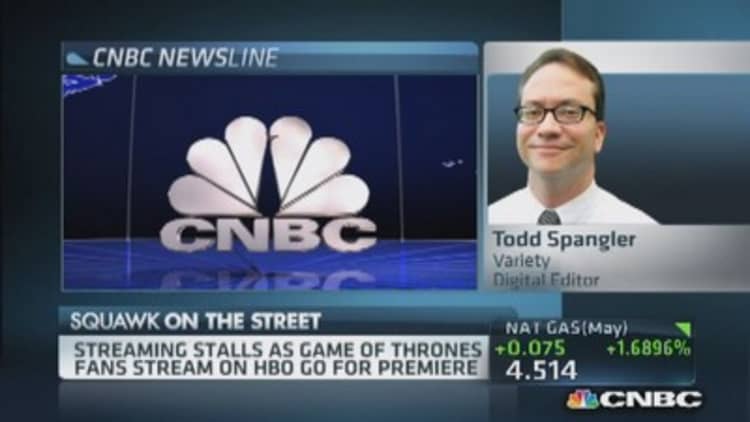When HBO needed to figure out why the "Game of Thrones" season premiere last year crashed for users of its streaming service, it turned to software developer AppDynamics.
So did Beachbody after fans of its popular 21 Day Fix weight-loss program suffered slow load times on mobile devices. And SAP's Concur unit counts on the same vendor to see where bugs emerge across its thousands of servers.
As software infiltrates every business on the planet, AppDynamics is on a mission to track every last line of it. Jyoti Bansal saw the world heading in that direction when he started the company seven years ago after leaving legacy software provider CA.
Read MoreDon't let software bugs ruin Christmas
From banks processing transactions on smartphones and insurers digitizing paper documents to telecom companies bringing customer support online and retailers gearing up for Cyber Monday, AppDynamics is winning deals as IT managers seek visibility across their entire network.
"All of these businesses have to build really complex software apps," said Bansal, 37, who studied computer science at the Indian Institute of Technology in the 1990s. "Retailers, insurance companies and big banks are not going to become software companies at scale without help. That's the trend we're playing into."
It shows in the latest numbers, which AppDynamics disclosed exclusively to CNBC.com
Annual revenue at the San Francisco-based company has more than doubled, with billings in the past 12 months topping $175 million. Billings refer to the amount of cash paid for contracts.

Unlike many software start-ups, AppDynamics was built to attack the enterprise market—companies big enough to eventually spend hundreds of thousands, if not millions, of dollars a year. AppDynamics, which was valued last year at $1.1 billion, now has 1,600 such customers.
Bansal said the top customers are spending several million dollars annually, and the biggest checks continue to increase in size as businesses go from using AppDynamics for a particular project or website to implementing it widely across the company.
Beachbody is among them, spending $160,000 a year and planning to increase that investment substantially. Known for the extreme workout program P90X, the company has a variety of other products, including the 21 Day Fix for losing weight and the Insanity interval training workout.
Read MoreP90X: Pumping up profits
Founded in 1998, Beachbody is an e-retailer, training site, media company and producer of workout supplements all wrapped together. That has led Michael Lee, Beachbody's vice president of technology, to lean heavily on AppDynamics. At any given moment, one unit is running a promotion and managing a swarm of new users, another is testing a mobile app and a third is moving from DVD fitness videos to streaming.
About 70 percent of Beachbody's servers are now being monitored by AppDynamics, providing insight about what programs are drawing engagement, which ones are effectively cross-promoting and which ones are losing customers because of excessive buffering.
"It can go everywhere you want it to go," said Lee. "If you're an enterprise company and you're looking to get a better understanding of your end users, AppDynamics is the right way to go."
AppDynamics funding rounds
| Round | Year | Investors (among others) | Amount |
| Series A | 2008 | Greylock, Lightspeed | $5.5 mln |
| Series B | 2010 | Greylock, Lightspeed | $11 mln |
| Series C | 2012 | Kleiner Perkins | $20 mln |
| Series D | 2013 | IVP | $50 mln |
| Series E | 2014 | Battery, ClearBridge | $70 mln |
On its surface, the market AppDynamics is pursuing looks limited. Application performance management (APM), its core business, was a $2.72 billion market in 2014 and is expected to grow 13 percent a year through 2019, according to Research and Markets.
Market share numbers from Gartner ranked AppDynamics as only the 11th-biggest player last year, behind companies including Dynatrace (formerly part of Compuware), CA, IBM, Microsoft, Splunk and New Relic.
But no company on the list is growing as fast. In fact, few software businesses at all are. Asheem Chandna of Greylock Partners invested in AppDynamics in 2008, when the company was just Bansal and a boatload of ambition.
Read MoreA holiday treat for tech investors: IPOs
Chandna has been a venture capitalist for 12 years, backing Palo Alto Networks and Arista Networks along the way. AppDynamics is on a very short list of software companies that have managed to continue doubling after reaching $100 million, he said.
"Jyoti saw early on that we were entering an era when software would transform the entire business landscape," Chandna said. "Even though they're seeing incredible growth, they're still very early in the journey."
Early, he says, because APM is just the starting point for AppDynamics. Bansal is really out to tackle the $21 billion IT operations management software market, which includes APM, and even the $15 billion business intelligence software market.
Remember, code is everywhere.
The previous generation of APM software was created before the digitization of the workplace and well ahead of the "Internet of everything." In Bansal's words, the "10-20-year old technologies were not designed for the 'software-is-eating-the-world' " era.
According to Gartner, the APM market is wide open. Dynatrace, the APM leader with 12.8 percent market share last year, is not sitting still. Since private equity firm Thoma Bravo split the APM business from Compuware in 2014, Dynatrace has slickened its approach and is growing faster than the market.
And AppDynamics certainly has to contend with New Relic, which earlier this month reported 69 percent first-quarter revenue growth to $38.1 million.
Read MoreBest-performing websites during the Super Bowl
Similar to AppDynamics, New Relic is focused on monitoring modern-day complex applications and enabling deep analytics. But the company, also based in San Francisco, started with the small-business market and is moving its way up, winning deals from the likes of News Corp. and Hearst.
New Relic CEO Lew Cirne positions his company as the pure software-as-a-service (SaaS) option, while AppDynamics is going after businesses that have yet to migrate to the cloud.
"Our competitors have done a fine job creating an on-premise business, but they are chasing a legacy APM market," said Cirne, who previously founded Wily Technology and sold it to CA in 2006. "New Relic is focused squarely on the future with our software analytics cloud. Ultimately, customers win in the cloud."
AppDynamics introduced a SaaS offering in 2010 and is competing aggressively for deals across the board. According to Bansal, supporting cloud and on-premise applications is critical, because big companies have both.
Read MoreAmazon lifts veil on cloud biz
"These enterprises do not have the luxury of running everything in a public cloud immediately, unlike a start-up getting off the ground," Bansal said. "Enterprises have complex hybrid architectures, especially when it comes to their most critical and largest software applications.
New Relic hit the public markets in December and is currently valued at $1.6 billion.
AppDynamics is clearly on a path towards an IPO of its own, having raised $120 million in equity and debt last year. Bansal isn't saying when an offering will happen, though he said it's just a matter of time.
The IPO markets haven't been kind to enterprise software companies of late, even those with fast-growing subscription models. Box's tumbling stock price this year has clogged up the pipeline, while New Relic has yet to produce gains following its opening-day pop.
They're either building software to drive growth or building software to drive efficiency.Jyoti Bansal, AppDynamics CEO
As an emerging company that sells to the largest corporations—20 percent of the Fortune 500—there are obvious reasons to be public. When weighing alternatives to IBM and Microsoft, giant banks and government bodies want to see a vendor's financials and have confidence that the business is stable and in it for the long haul.
That introduces another risk for AppDynamics. The company has grown alongside an extended technology bull market and six consecutive years of gains for U.S. stocks. We don't yet know if it's recession-proof.
Read MoreWhy start-ups need to start listening to the Fed
Bansal isn't concerned. For every customer installing AppDynamics on new projects, he sees another using the technology to eliminate costly bottlenecks.
"They're either building software to drive growth or building software to drive efficiency," he said.

Concur, the travel and expense software company that SAP bought for more than $8 billion, installed AppDynamics about a year ago to gain visibility into its three data centers and understand the variety of experiences customers were having across them.
The company has since cut down the amount of time it takes to detect problems by 20 percent and is able to dig into the most granular issues, said Kevin Evans, vice president of infrastructure at Concur. Such issues include why an expense report failed to load or why it took so long for a new client to book a hotel.
"There are flashlights finding things all over the place, illuminating things we didn't know," Evans said.
Read MoreDocker's rise from sleeper to open source king
Concur's spending with AppDynamics has increased by about 40 percent since the original installation, which is typical. AppDynamics says its average customer spends 30 to 40 percent more each year.
In May, AppDynamics put out a press release announcing HBO GO as a new customer. With TV watching moving to the web, HBO's hit programs "Game of Thrones" and "True Detective" experienced widely reported streaming glitches, an embarrassment for a company trying to match the performance of Netflix and Amazon.com.
AppDynamics' software was tasked with finding potential trouble spots ahead of time, a big deal for a show like "Game of Thrones," which attracts close to 8 million viewers per episode.
"AppDynamics gives us the visibility to find and fix potential choke points before they impact the viewing experience," Gilman Wong, senior vice president of digital products at HBO, said in the statement.

Bansal can reel off similar types of anecdotes from companies across the spectrum, whether it's Expedia in online travel or Pizza Pizza, a Canadian restaurant chain with over 700 stores.
To meet demand, AppDynamics has been on a hiring spree, increasing its head count to 800 from 450 a year ago.
Read MoreWall Street's ongoing struggle to make sense of the cloud
What keeps Bansal up at night is managing such rapid growth while ensuring that customer satisfaction remains high and employees stay engaged. Like so many software entrepreneurs before him, he's mindful of maintaining the "start-up ethos."
But do it right, and Bansal has grand visions for what's possible. "We have an opportunity to be next big great tech company," he said.


